I Tried 6 Frozen Fish Sticks & One Was Perfectly Buttery and Tender
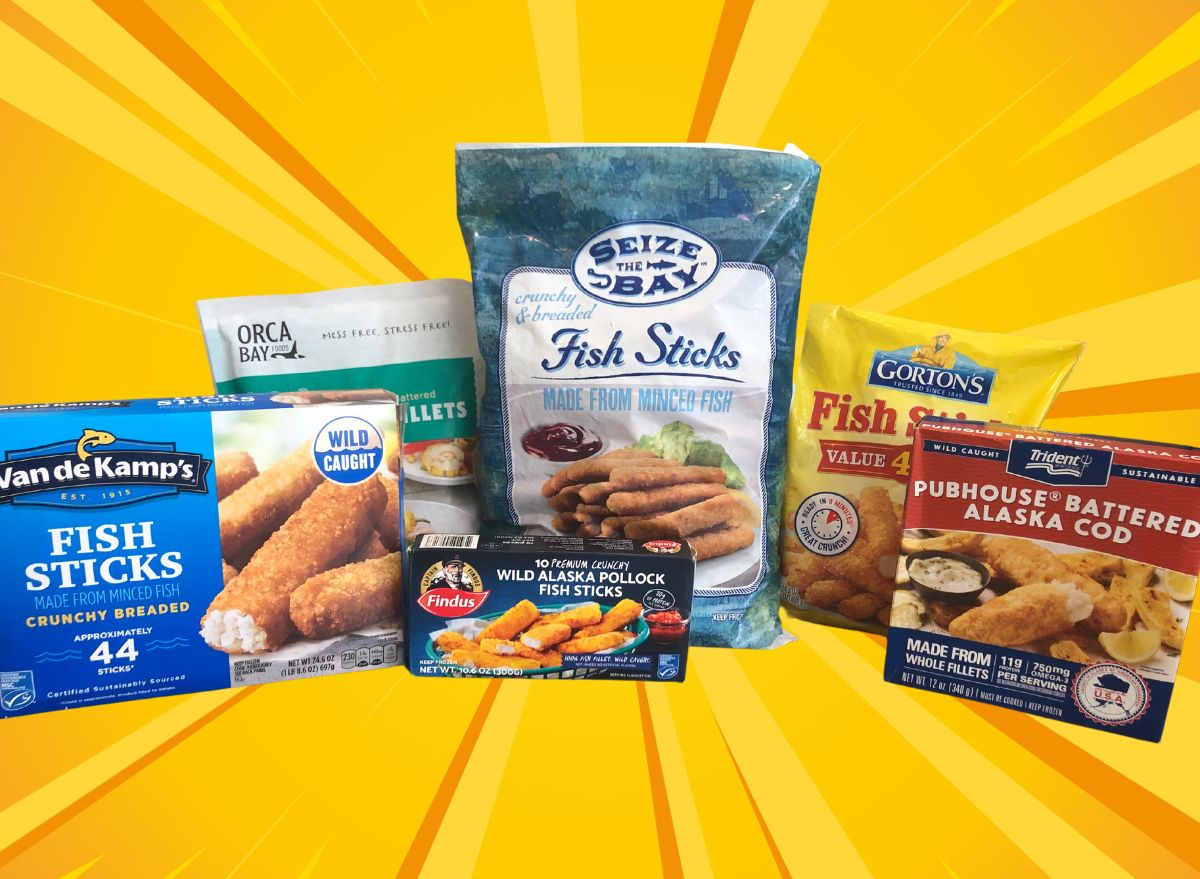
Breaded seafood from the freezer section is a dinner staple in many households—not because it's necessarily healthy, of course, but because it's easy. It's quick to prepare, and it typically doesn't garner many complaints from the little ones. The fact that it's blanketed in a crunchy coating and can be dunked in any sauce of your choice, from tartar to ketchup, surely contributes to its broad appeal.
In my house growing up, our marine-based meal of choice was always popcorn shrimp, a dinner my sisters and I would gobble down on Monday nights right before heading to dance class. I also believe this is how I acquired my unhealthy obsession with cocktail sauce.
However, I had much less exposure to fried fish. My mom would occasionally swing by Long John Silver's for a few pieces of either pollock or cod, which she would generously douse in vinegar–a controversial choice among other members of the household. But frozen fish or fish sticks were rarely on the menu at home.
So, I was able to approach this fishy taste test with fresh eyes. Diving right in, I rounded up six different brands of fish sticks from my local supermarkets. I also went bold and decided to use my air fryer to cook them up. I felt this was the most appropriate choice to ensure a crispy finished product.
As I began my assessment, I did have a few standards that needed to be met for each stick. Even with my limited experience, I knew that each one needed to include noticeably real-looking white fish. More often than not, this ended up being pollock. The batter or breading also needed to be nice and crisp with at least a little bit of added flavor but not overwhelming to the star of the show. And that's it. Simple enough, right?
Based on these fairly straightforward requirements, let's jump into which brands fared best, ranked from my least to most favorite fish stick.
Seize the Bay Fish Sticks
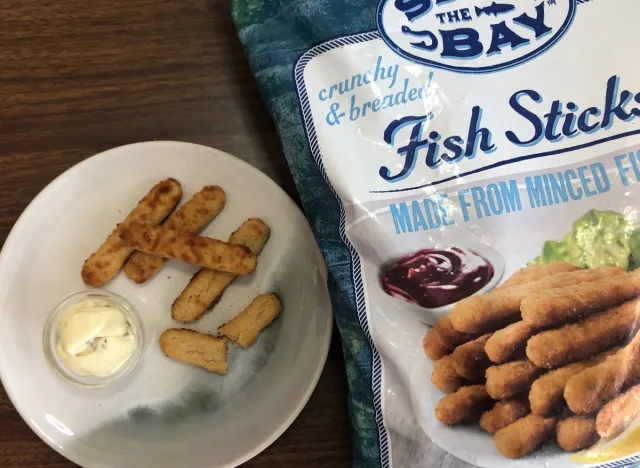
Calories: 290
Fat: 12 g (Saturated Fat: 2 g)
Sodium: 600 mg
Carbs: 31 g (Fiber: 3 g, Sugar: 3 g)
Protein: 13 g
If you're throwing a neighborhood fish fry, Seize the Bay is a name you'll want to know. The brand's fish sticks come in a massive four-pound bag that holds an estimated 128 pieces, or enough to feed a whale and then some. And yes, I did diligently look for a more manageable size, but to no avail. So, I will be snacking on them for the foreseeable future.
Each stick is breaded and inside is a minced medley of pollock, sole, cod, haddock, and whiting. (If you're unfamiliar with the latter, it's a light and mild-tasting member of the cod family, but much cheaper.) The gargantuan bag of fish sticks cost me a very reasonable $7.99.
The Look: Light and definitely small. These sticks are so skinny that I was wondering how any fish at all could be stuffed inside of them. The breading also began to crack down the middle as the sticks crisped up in the air fryer–a signal to me that they could be severely dry.
The Taste: All of my preconceived notions and fears unfortunately turned out to be correct. As I bit into the first stick, I could hardly discern the breading from the fish. Both are the same color—a muted brown—and feature the same mushy texture. I would have guessed this to be more of a fish paste or whipped fish than anything else. And, the seafood essence is so faint that the smell is more intense than the taste. The breading didn't score any points here either, adding next to nothing of value—not even a hint of salt.
I will refrain from being wasteful and tossing these in the trash. But, I will likely be unloading the remainder of my four-pound bag onto a more forgiving friend.
Gorton's Fish Sticks
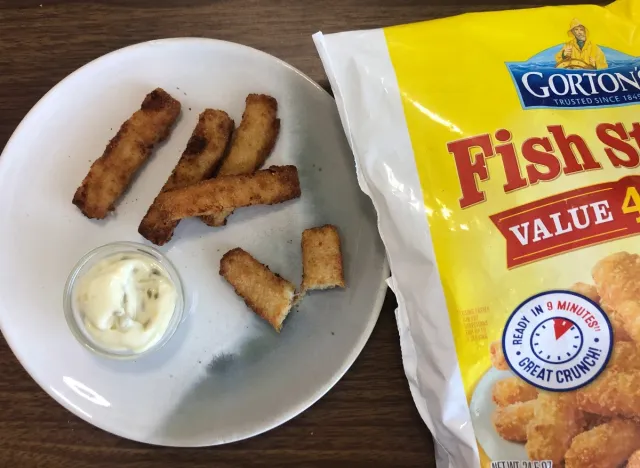
Calories: 180
Fat: 8 g (Saturated Fat: 1 g)
Sodium: 310 mg
Carbs: 18 g (Fiber: 1 g, Sugar: 1 g)
Protein: 8 g
The Gorton's fisherman is a familiar face in the frozen aisle, always dressed in his yellow raincoat while he braves the weather and steers his boat. The brand covers every category of fried seafood imaginable from butterfly fish to clams. But, one of its trusty basics has always been plain and simple fish sticks.
Minced Alaska pollock is the fish of choice for these classics, and it's always 100% real as well as wild-caught. I bought a one-pound bag containing about 45 sticks for $7.39—only to come home and realize I already had a bag harbored in the back of my freezer from long ago. Whoops!
The Look: Squared off and inconsistently sized. The shape reminds me of a fried zucchini stick. I was half expecting a green vegetable to come oozing out. Some sticks are also much skinnier than others, causing a bit of uneven cooking. The breading developed into a promising shade of brown, though. And, the best part is that the fish at the center actually looked white and fishy—already a major leg up against Seize the Bay's offering.
The Taste: Rigid, dry, and flavorless. I felt like I was munching on each bite for an eternity and there were no flavors to enjoy during that time whatsoever. The pollock was hardly noticeable stuck between copious amounts of breading. But, it too had an undesirable consistency. Since it is minced, it ended up too compact and gummy. Not a great showing from the esteemed fisherman.
Findus Wild Alaska Pollock Fish Sticks
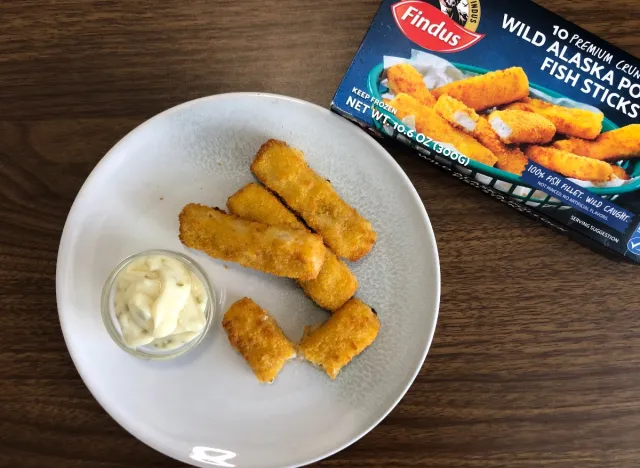
Calories: 290
Fat: 12 g (Saturated Fat: 1 g)
Sodium: 570 mg
Carbs: 27 g (Fiber: 1 g, Sugar: 1 g)
Protein: 20 g
As opposed to Gorton's, Captain Findus is not a name I was familiar with. And, I almost missed the brand's dainty blue box altogether as I scouted out my local Giant Eagle's seafood section. It turns out the captain is owned by U.K.-based Norman Foods, one of Europe's largest frozen food companies which also owns BirdsEye. Under the Findus line, you can find battered, breaded, and baked fish. The fish sticks specifically are made with wild Alaska pollock—not minced—and come in a box of 10 for just $2.
The Look: Wide and rectangular. This is the fish stick shape and look. It's the first contender that offers more fish than breading and is also the first that is not minced. So, the insides are white and actually resemble a real fish fillet—probably because it's made from one—instead of looking like a smooshed-together mess.
The Taste: The fish is more squishy than flakey, and a few spots even look raw. I also came across gray spots throughout the flesh, which really hindered my appetite. I wondered if I just received a bad batch. Since the bread crumbs came in a thinner layer, it was less snappy than other fish sticks, but was still tasteful. These sticks also receive a few extra points just for having such a simplified ingredient list—just seven total, if you don't break down the bread crumbs further.
Van de Kamp's Fish Sticks
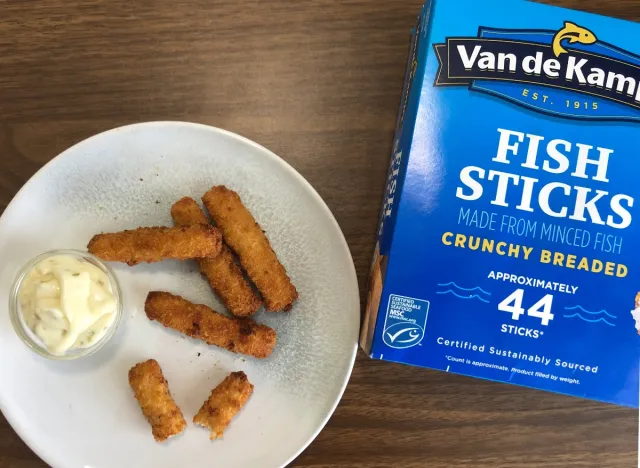
Calories: 230
Fat: 10 g (Saturated Fat: 1.5 g)
Sodium: 440 mg
Carbs: 22 g (Fiber: <1 g, Sugar: <1 g)
Protein: 10 g
Breaded fish, whether it be fillets, sticks, or sandwich patties, is Van de Kamp's specialty. It's all the company knows and it takes great pride in its line of work. Over 95% of its seafood, which includes haddock, pollock, and flounder, is wild-caught. And, 99% of this wild-caught fish is also certified by the Marine Stewardship Council (MSC).
Wild-caught minced pollock is what happens to be inside the Van de Kamp's Fish Sticks. The original sticks come in quantities of 18, 44, or 60, and there is additionally a Jumbo Fish Sticks option. I stuck with the original in a 44-count box which cost me $6.49.
The Look: Puny. In fact, these may be even smaller than Seize the Bay's. I now understand why a total of six whole fish sticks makes up a serving. They also look suspiciously like a tiny mozzarella stick with its crumby yet crispy looking breading.
The Taste: First-class crunchy breading, but not enough fish. The crust—which is made of up all the usual suspects like wheat flour, soybean oil, salt, yeast, and cornstarch—is spot on. It has the right amount of flavor with some garlic, onion powder, and paprika thrown in and creates the perfect crackle with each bite. The fish, however, is mediocre at best, and there's simply not enough. Maybe the jumbo-sized sticks would have been a better choice. The white meat is firmly pressed together, and when isolated, it is dull, dry and chewy—a fishy trifecta for sure.
Trident Seafoods Pubhouse Battered Alaska Cod
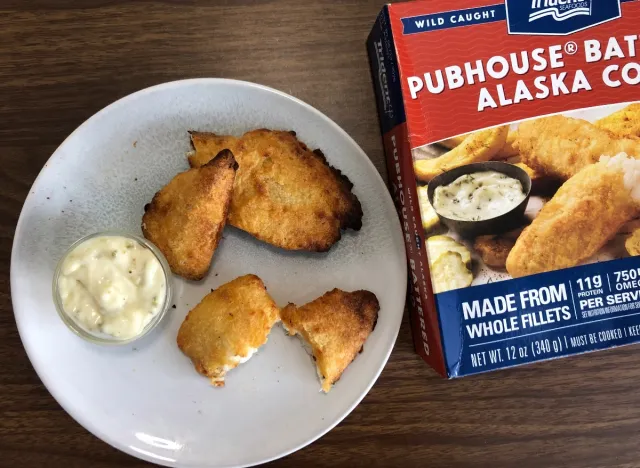
Calories: 190
Fat: 8 g (Saturated Fat: 0.5 g)
Sodium: 510 mg
Carbs: 19 g (Fiber: 0 g, Sugar: 1 g)
Protein: 11 g
Trident Seafoods is the largest seafood company in the United States. Its products are stocked at supermarkets all across the country. But, during my grocery adventure featuring multiple stops, all I found was the brand's PubHouse Battered Alaska Cod at my local Target. Maybe Columbus, Ohio, just isn't a big seafood hub and market (not surprising). The fish slices are made from whole cod fillets and are the first in this taste test that are battered versus breaded—a small detail which makes a big difference in terms of looks and taste. A box of seven cost me $6.79, almost a dollar each.
The Look: Smooth outside and flaky inside. Each piece is more of a triangular shape than the elongated design shown on the packaging. They are not crumby and coarse like the others, but have a polished exterior from the batter. The fillet appears fresh enough—although more of a cream-color rather than white—and the lines and layers of meat are visible.
The Taste: A melt-in-your-mouth pairing of both batter and fish. The fillet felt almost silky on my tongue and remained juicy even after spending some time in the air fryer. Its flavor notes were mild and not abrasively fishy. I didn't pick up on the sweetness that sometimes accompanies cod, unfortunately, but I don't think it was even needed. Moving on though, I think I may have enjoyed the glazing of batter even more than the fish itself. It had a bit of a cracker-like flavor (similar to Ritz) and gave off a light crunch while also being quite moist. Even so, there is one brand that I enjoyed even more.
Orca Bay Foods Gluten-Free Battered Fish Fillets
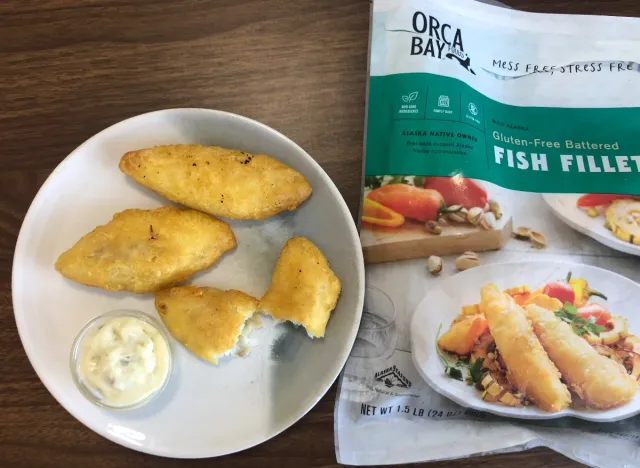
Calories: 140
Fat: 8 g (Saturated Fat: 0.5 g)
Sodium: 220 mg
Carbs: 9 g (Fiber: 0 g, Sugar: 0 g)
Protein: 7 g
After discovering the Findus brand, I additionally fished these fillets out of my local Giant Eagle's freezers. I was surprised when I saw them since Orca Bay is most well-known for its non-breaded fish steaks, which range from salmon and swordfish to tilapia and tuna.
These fish fillets actually take on more of a stick shape, a large reason why I still decided to include them. They are also concealed in a gluten-free pub-style batter and are made from wild-caught Alaska pollock, which seems to be standard for most frozen fish sticks. A bag containing 10 pieces was priced at $13.49—definitely not the most economical choice.
The Look: Identical to what you would be served in a restaurant's fish and chip basket. Each golden pocket is filled with bright white and flakey pollock. The batter layer is just right, not too thick and not too thin. Similar to Trident's Battered Cod, it also has more of a muted crunch—with the exception of a spot on its backside where it was lying in the air fryer. This section became just a tad spongy.
The Taste: Buttery and tender. The savory smell of both batter and fish filled the air as these finished up in the air fryer, making my mouth water. The pollock managed to be firm in addition to both delicate and lean. I also never would have guessed that the batter was gluten-free. Its texture is puffy, not too oily, and it has a slightly garlicky and salty finish. Add in a couple of drops of tangy tartar sauce, and this was near perfection. It is also one of the best gluten-free products I've had in a while. Orca Bay certainly doesn't need to fish for compliments any time soon. Praise will come naturally as long as it sticks to this killer recipe.
Why Trust Eat This, Not That!?
Eat This, Not That! is committed to creating high-quality content that you can trust to be accurate, properly researched, routinely reviewed, and updated with the latest information. Our writers, editors, and medical and/or certified experts consider this to be an unwavering promise we make to our readers in the pursuit of delivering impactful and meaningful content.









